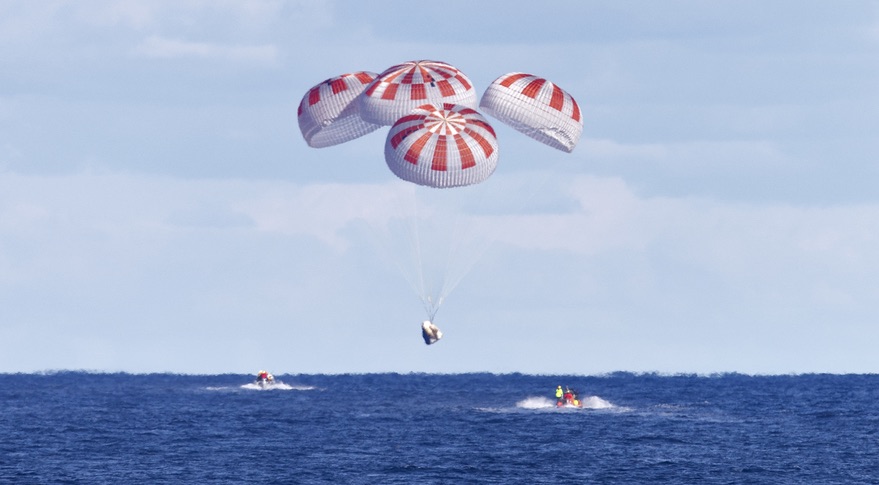Crew Dragon Parachutes Failed in Recent Test

WASHINGTON — A test of parachutes for SpaceX's Crew Dragon spacecraft did not go as planned last month, NASA and SpaceX confirmed May 8.
During a hearing of the House Science Committee's space subcommittee on NASA's exploration plans, Rep. Mo Brooks (R-Ala.) quizzed agency officials on the testing of parachutes for commercial crew vehicles, zeroing in on a specific, previously undisclosed test in April.
"Did SpaceX conduct, in April of 2019, a parachute test in Delamar Dry Lake, Nevada?" he asked. "What happened in that test?"
Related: SpaceX Crew Dragon Splashes Down in Atlantic to Cap Historic Test Flight
"The test was not satisfactory," responded Bill Gerstenmaier, NASA associate administrator for human exploration and operations and one of the witnesses at the hearing. "We did not get the results we wanted, but we learned some information that's going to affect, potentially, future parachute designs."
In that test, one of the four parachutes was "proactively failed" to demonstrate the "single-out" capability of the overall system. However, he said, "the three remaining chutes did not operate properly." That caused a test sled to hit the ground faster than expected, damaging it.
An industry source, speaking on background after the hearing, confirmed the problem with what SpaceX considered an "advanced development test" of the parachute system "specifically designed to measure loads within each parachute canopy." One of the four chutes was deliberately disabled, but the other three did not open fully.
Breaking space news, the latest updates on rocket launches, skywatching events and more!
Gerstenmaier said the cause of the failure wasn't known yet. "We still need to understand whether it was a test setup configuration coming out of the aircraft or if there was something associated with the packing of the parachutes, the rigging, all that," he said. He noted that the parachutes had instrumented lines to measure loads, which will provide important data for that investigation.
He emphasized that such failures are part of the overall testing process that will improve the ultimate design of the parachute system. "I don't see this as a negative. This is why we test. This is why we want to push things," he said. "This is a gift to us. We've gotten data that is unique that will help us design and understand if this is something that needs to be fixed or if it's something that was a nuance of the test."
Parachute development has been an issue for both Boeing and SpaceX during commercial crew development, an issue highlighted at several recent meetings of the Aerospace Safety Advisory Panel. "Clearly, one cannot risk crew without there being a complete confidence in the parachute design," Don McErlean, a member of the panel, said at a meeting last October that discussed issues with both companies' testing of parachutes.
Patricia Sanders, chair of the panel and another witness at the May 8 hearing, noted there have been a "large number" of parachute tests conducted for the commercial crew vehicles as well as for the Orion spacecraft. "They've made a great deal of progress in understanding those uncertainties involved in that," she said. "It's one of the larger risks they have."
"There have been a number of positive tests" of parachute systems in recent months, she said. "There have been a few less satisfactory results and some tests that are indicating that there may need to be some redesign or some adjustments made to the design." She didn't get into specifics of those tests beyond the problem with the April SpaceX test.
SpaceX said that, prior to last month's test, it had performed five similar "parachute-out" tests where one of the four parachutes deliberately did not open. All of those were completed successfully. The company has performed 19 tests of the parachute system to date with "a number of additional tests" planned before the Demo-2 test flight of the Crew Dragon vehicle, with two NASA astronauts on board.
- Read SpaceNews for the Latest Space Industry News
- SpaceX Crew Dragon Accident Another Bump in the Road for Commercial Crew
- Parachutes Pop Perfectly In SpaceX Test
This story was provided by SpaceNews, dedicated to covering all aspects of the space industry.

Jeff Foust is a Senior Staff Writer at SpaceNews, a space industry news magazine and website, where he writes about space policy, commercial spaceflight and other aerospace industry topics. Jeff has a Ph.D. in planetary sciences from the Massachusetts Institute of Technology and earned a bachelor's degree in geophysics and planetary science from the California Institute of Technology. You can see Jeff's latest projects by following him on Twitter.

